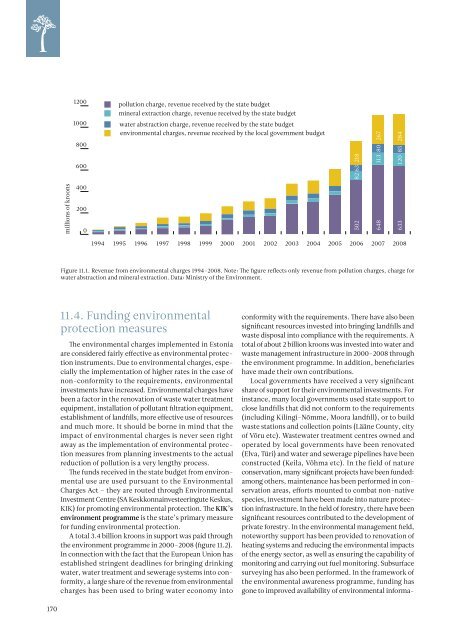ESTONIAN ENVIRONMENTAL REVIEW 2009
ESTONIAN ENVIRONMENTAL REVIEW 2009
ESTONIAN ENVIRONMENTAL REVIEW 2009
Create successful ePaper yourself
Turn your PDF publications into a flip-book with our unique Google optimized e-Paper software.
1200<br />
pollution charge, revenue received by the state budget<br />
mineral extraction charge, revenue received by the state budget<br />
millions of kroons<br />
1000<br />
800<br />
600<br />
400<br />
200<br />
0<br />
water abstraction charge, revenue received by the state budget<br />
environmental charges, revenue received by the local government budget<br />
502 82 63 218<br />
648 113 80 267<br />
633 120 85 284<br />
1994<br />
1995<br />
1996<br />
1997<br />
1998<br />
1999<br />
2000<br />
2001 2002 2003 2004 2005 2006 2007 2008<br />
Figure 11.1. Revenue from environmental charges 1994–2008. Note: The figure reflects only revenue from pollution charges, charge for<br />
water abstraction and mineral extraction. Data: Ministry of the Environment.<br />
11.4. Funding environmental<br />
protection measures<br />
The environmental charges implemented in Estonia<br />
are considered fairly effective as environmental protection<br />
instruments. Due to environmental charges, especially<br />
the implementation of higher rates in the case of<br />
non-conformity to the requirements, environmental<br />
investments have increased. Environmental charges have<br />
been a factor in the renovation of waste water treatment<br />
equipment, installation of pollutant filtration equipment,<br />
establishment of landfills, more effective use of resources<br />
and much more. It should be borne in mind that the<br />
impact of environmental charges is never seen right<br />
away as the implementation of environmental protection<br />
measures from planning investments to the actual<br />
reduction of pollution is a very lengthy process.<br />
The funds received in the state budget from environmental<br />
use are used pursuant to the Environmental<br />
Charges Act – they are routed through Environmental<br />
Investment Centre (SA Keskkonnainvesteeringute Keskus,<br />
KIK) for promoting environmental protection. The KIK’s<br />
environment programme is the state’s primary measure<br />
for funding environmental protection.<br />
A total 3.4 billion kroons in support was paid through<br />
the environment programme in 2000–2008 (figure 11.2).<br />
In connection with the fact that the European Union has<br />
established stringent deadlines for bringing drinking<br />
water, water treatment and sewerage systems into conformity,<br />
a large share of the revenue from environmental<br />
charges has been used to bring water economy into<br />
conformity with the requirements. There have also been<br />
significant resources invested into bringing landfills and<br />
waste disposal into compliance with the requirements. A<br />
total of about 2 billion kroons was invested into water and<br />
waste management infrastructure in 2000–2008 through<br />
the environment programme. In addition, beneficiaries<br />
have made their own contributions.<br />
Local governments have received a very significant<br />
share of support for their environmental investments. For<br />
instance, many local governments used state support to<br />
close landfills that did not conform to the requirements<br />
(including Kilingi-Nõmme, Moora landfill), or to build<br />
waste stations and collection points (Lääne County, city<br />
of Võru etc). Wastewater treatment centres owned and<br />
operated by local governments have been renovated<br />
(Elva, Türi) and water and sewerage pipelines have been<br />
constructed (Keila, Võhma etc). In the field of nature<br />
conservation, many significant projects have been funded:<br />
among others, maintenance has been performed in conservation<br />
areas, efforts mounted to combat non-native<br />
species, investment have been made into nature protection<br />
infrastructure. In the field of forestry, there have been<br />
significant resources contributed to the development of<br />
private forestry. In the environmental management field,<br />
noteworthy support has been provided to renovation of<br />
heating systems and reducing the environmental impacts<br />
of the energy sector, as well as ensuring the capability of<br />
monitoring and carrying out fuel monitoring. Subsurface<br />
surveying has also been performed. In the framework of<br />
the environmental awareness programme, funding has<br />
gone to improved availability of environmental informa-<br />
170

















